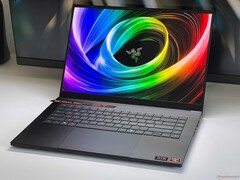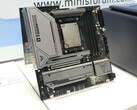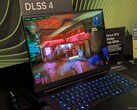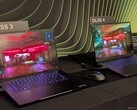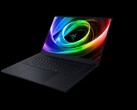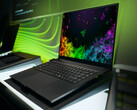Razer is known for bringing relatively slim laptops with a maximum performance to the market. But last year, this changed with the Blade 16, since the case was noticeably thicker, which had a positive effect on the emissions. For 2025, Razer now returns to a 30% slimmer case. While this brings of course some advantages in mobility, in terms of the performance and maintenance options, the new model looks more like a step back, despite including the RTX 5090 Laptop.
This already begins with the processor, where instead of a fast HX processor from AMD or Intel, a regular mobile processor from AMD that can also be found in subnotebooks is used. Even though with a TDP slightly higher than 80 watts, the CPU performance isn't bad at all, there is still a significant difference to the faster models here. This becomes particularly noticeable when gaming in the 1080p resolution, although it becomes negligeable in combination with the RTX 5090 Laptop. What is more problematic is that the Ryzen chip is offered here with soldered memory. This is a significant step back and very unfortunate, since at this point, the Ryzen AI CPUs are also available with expandable RAM (see the Schenker Evo lineup).
The new GeForce RTX 5090 Laptop shows its advantage particularly in very high resolutions and when DLSS and Frame Generation are used, but those who already have a powerful RTX 4090 Laptop don't really need the upgrade. This is confirmed by the statements from Nvidia that say that the RTX 5000 series is meant as an upgrade for users of the RTX 3000 generation. However, it is sobering that the performance increases aren't higher after such a long time. Here, you can simply see that Nvidia doesn't have any larger competitors in the mobile arena. But with a maximum TGP of 160 watts, at least Razer uses a fairly powerful version of the RTX 5090 Laptop. This places it significantly ahead of its main competitor, the Asus ROG Zephyrus G16, where the RTX 5090 Laptop is only allowed to consume a maximum of 120 watts. We will already be able to find out in a few days, how the new ROG Zephyrus fares in our tests.
The display of the Blade 16 basically leaves a good impression, and the 240-Hz OLED panel is excellently suited for gaming. In addition, Razer already delivers some very well calibrated color profiles in the state of delivery. The weaknesses of the panel are the slightly disappointing brightness values, particularly in HDR mode.
While the Blade 16 is definitely a good mobile gaming laptop overall, you won't get the maximum performance here anymore. Particularly considering the native WQHD resolution, choosing the RTX 5080 Laptop or the RTX 5070 Ti Laptop might clearly make more sense in the current Blade 16. You can find all the additional information including benchmarks and measurement results in our detailed test of the Razer Blade 16 2025.
Source(s)
Razer Blade 16 (2025) review by Notebookcheck




